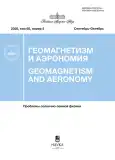Variations of some solar activity indices and magnetic fields of coronal holes of cycle 25
- Autores: Andreeva O.A.1, Illarionov E.A.2,3
-
Afiliações:
- Crimean Astrophysical Observatory RAS (CrAO RAS)
- Lomonosov Moscow State University (MSU)
- Moscow Center of Fundamental and Applied Mathematics
- Edição: Volume 65, Nº 5 (2025)
- Páginas: 590-598
- Seção: Articles
- URL: https://journal-vniispk.ru/0016-7940/article/view/352718
- DOI: https://doi.org/10.7868/S3034502225050035
- ID: 352718
Citar
Resumo
Variations in the sunspot areas and indices, as well as the areas and magnetic fluxes of coronal holes are considered for the first five years of Cycle 25. The analysis is based on the source data from https://observethesun.com. The magnetic fluxes of coronal holes were calculated from the synoptic maps of magnetic fields obtained from two independent instruments: the Helioseismic and Magnetic Imager/Solar Dynamics (HMI/SDO) and the Solar Operational Prediction Telescope/Kislovodsk Mountain Astronomical Station of the Pulkovo Observatory (STOP/KGAS). The study of variations of the monthly indices and sunspot areas in both hemispheres revealed a pronounced asymmetry in the sunspot production rate during the period under consideration in favor of the southern hemisphere. In the same period, a significant asymmetry was also observed in the occurrence time and amplitude of polar and low-latitude coronal holes. At the beginning of the period from January 2020 to April 2022, the main contribution to the total area was made by polar coronal holes. Then, the contribution of low-latitude coronal holes dominated until the end of the period under consideration, although at certain moments the contribution of both types of coronal holes was significant. A comparative analysis of the dynamics of magnetic fluxes of coronal holes based on the HMI/SDO and STOP/KGAS synoptic maps for the same period (2014-2024) showed a good agreement between the results. This is a strong argument in favor of a regular use of domestic instruments, in particular STOP/KGAS, in studying the evolution of solar magnetic fields.
Palavras-chave
Sobre autores
O. Andreeva
Crimean Astrophysical Observatory RAS (CrAO RAS)
Autor responsável pela correspondência
Email: olga@craocrimea.ru
Nauchny, Russia
E. Illarionov
Lomonosov Moscow State University (MSU); Moscow Center of Fundamental and Applied Mathematics
Email: egor.illarionov@math.msu.ru
Moscow, Russia; Moscow, Russia
Bibliografia
- Витинский Ю.И. Солнечная активность. 2-е изд. М.: Наука, 192 с. 1983.
- Ишков В.Н. Текущий 25 солнечный цикл в год максимума: солнечные активные явления и прогноз их развития на ветви спада / Физика плазмы в Солнечной системе / Сборник тезисов ХХ Ежегодной конференции. Москва, 10−14 февраля 2025 г. М.: ИКИ. С. 20. 2025.
- Обридко В.Н. Магнитные поля и индексы активности / Плазменная гелиогеофизика. Т. 1. Ред. Л.М. Зеленый, И.С. Веселовский. M.: Физматлит. С. 41−59. 2008.
- Обридко В.Н., Наговицын Ю.А. Солнечная активность, цикличность и методы прогноза. СПб.: ВВМ, 466 c. 2017.
- Пещеров В.С., Григорьев В.М., Бевзов А.Н. и др. Солнечный телескоп оперативных прогнозов нового поколения // Автометрия. Т. 49. № 6. С. 62−69. 2013.
- Abramenko V., Yurchyshyn V., Watanabe H. Parameters of the magnetic flux inside coronal holes // Solar Phys. V. 260. № 1. P. 43–57. 2009. https://doi.org/10.1007/s11207-009-9433-7
- Andreeva O. Comparison of the dynamics of coronal holes identified by two detection methods in solar activity cycles 24−25 / Modern astronomy: from the Early Universe to exoplanets and black holes / Proc. All-Russian Astronomical Conference VAK-2024. Nizhny Arkhyz, August 25–31, 2024. P. 517−522. 2024. http://dx.doi.org/10.26119/VAK2024.097
- Bilenko I.A., Tavastsherna K.S. Coronal hole and solar global magnetic field evolution in 1976–2012 // Solar Phys. V. 291. N 8. P. 2329–2352. 2016. https://doi.org/10.1007/s11207-016-0966-2
- Cranmer S.R. Coronal holes // Living Rev. Sol. Phys. V. 6. ID 3. 2009. https://doi.org/10.12942/lrsp-2009-3
- Illarionov E.A., Tlatov A.G. Segmentation of coronal holes in solar disk images with a convolutional neural network // Mon. Not. R. Astron. Soc. V. 481. № 4. P. 5014–5021. 2018. https://doi.org/10.1093/mnras/sty2628
- Illarionov E.A., Kosovichev A.G., Tlatov A.G. Machine-learning approach to identification of coronal holes in solar disk images and synoptic maps // Astrophys. J. V. 903. № 2. ID 115. 2020. https://doi.org/10.3847/1538-4357/abb94d
- Lemen J.R., Title A.M., Akin D.J. et al. The Atmospheric Imaging Assembly (AIA) on the Solar Dynamics Observatory (SDO) // Solar Phys. V. 275. № 1–2. P. 17–40. 2012. https://doi.org/10.1007/s11207-011-9776-8
- Luhmann J.G., Li Y., Lee C.O., Jian L.K., Arge C.N., Riley P. Solar cycle variability in coronal holes and their effects on solar wind sources // Space Weather. V. 20. № 10. ID e2022SW003110. 2022. https://doi.org/10.1029/2022SW003110
- Martin S. Observations key to understanding solar cycles: a review // Front. Astron. Space Sci. V. 10. ID 1177097. 2024. https://doi.org/10.3389/fspas.2023.1177097
- Nagovitsyn Yu.A., Georgieva K., Osipova A.A., Kuleshova A.I. Eleven year cyclicity of the sun on the 2000-year time scale // Geomagn. Aeronomy. V. 55. № 8. P. 1081–1088. 2015. https://doi.org/10.1134/S001679321508023X
- Obridko V.N., Shelting B.D., Livshits I.M., Asgarov A.B. Contrast of coronal holes and parameters of associated solar wind streams // Solar Phys. V. 260. № 1. P. 191–206. 2009. https://doi.org/10.1007/s11207-009-9435-5
- Priest E. Magnetohydrodynamics of the Sun. Cambridge: Cambridge University Press, 580 p. 2014. https://doi.org/10.1017/CBO9781139020732
- Scherrer P.H., Schou J., Bush R.I. et al. The Helioseismic and Magnetic Imager (HMI) investigation for the Solar Dynamics Observatory (SDO) // Solar Phys. V. 275. № 1–2. P. 207–227. 2012. https://doi.org/10.1007/s11207-011-9834-2
- Yeates A.R., Cheung M.C.M., Jiang J., Petrovay K., Wang Y.-M. Surface flux transport on the Sun // Space Sci. Rev. V. 219. № 4. ID 31. 2023. https://doi.org/10.1007/s11214-023-00978-8
Arquivos suplementares









